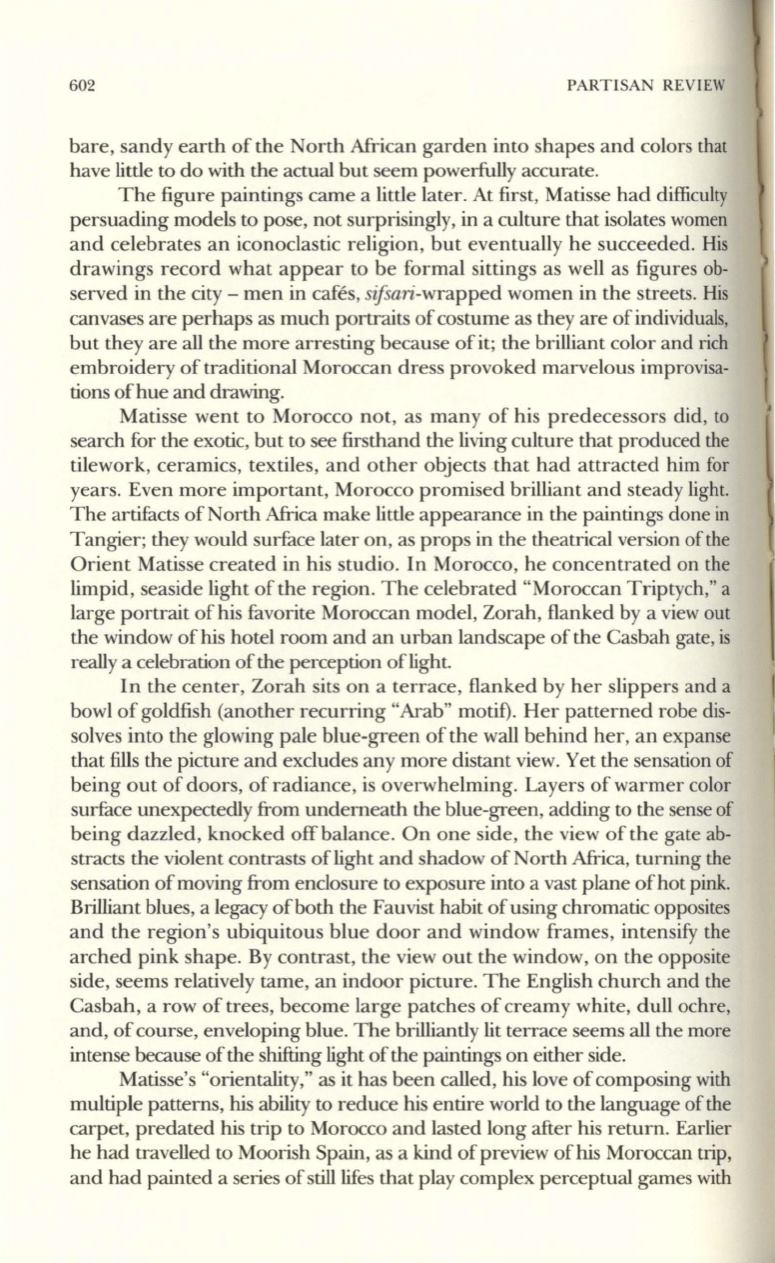
602
PARTISA REVIEW
bare, sandy earth of the North African garden into shapes and colors that
have little to do with the actual but seem powerfully accurate.
The figure paintings came a little later. At first, Matisse had difficulty
persuading models to pose, not surprisingly, in a culture that isolates women
and celebrates an iconoclastic religion, but eventually he succeeded. His
drawings record what appear to be formal sittings as well as figures ob–
served in the city - men in cafes,
sifSari-wrapped
women in the streets. His
canvases are perhaps as much portraits of costume as they are of individuals,
but they are all the more arresting because of it; the brilliant color and rich
embroidery of traditional Moroccan dress provoked marvelous improvisa–
tions of hue and drawing.
Matisse went to Morocco not, as many of his predecessors did, to
search for the exotic, but to see firsthand the living culture that produced the
tilework, ceramics, textiles, and other objects that had attracted him for
years. Even more important, Morocco promised brilliant and steady light.
The artifacts of North Africa make little appearance in the paintings done in
Tangier; they would surface later on, as props in the theatrical version of the
Orient Matisse created in his studio. In Morocco, he concentrated on the
limpid, seaside light of the region. The celebrated "Moroccan Triptych," a
large portrait of his favorite Moroccan model, Zorah, flanked by a view out
the window of his hotel room and an urban landscape of the Casbah gate, is
really a celebration of the perception of light.
In the center, Zorah sits on a terrace, flanked by her slippers and a
bowl of goldfish (another recurring "Arab" motif). Her patterned robe dis–
solves into the glowing pale blue-green of the wall behind her, an expanse
that fills the picture and excludes any more distant view. Yet the sensation of
being out of doors, of radiance, is overwhelming. Layers of warmer color
surface unexpectedly from underneath the blue-green, adding to the sense of
being dazzled, knocked off balance. On one side, the view of the gate ab–
stracts the violent contrasts of light and shadow of North Africa, turning the
sensation ofmoving from enclosure to exposure into a vast plane of hot pink.
Brilliant blues, a legacy of both the Fauvist habit of using chromatic opposites
and the region'S ubiquitous blue door and window frames, intensify the
arched pink shape. By contrast, the view out the window, on the opposite
side, seems relatively tame, an indoor picture. The English church and the
Casbah, a row of trees, become large patches of creamy white, dull ochre,
and, of course, enveloping blue. The brilliantly lit terrace seems
all
the more
intense because of the shifting light of the paintings on either side.
Matisse's "orientality," as it has been called, his love of composing with
multiple patterns, his ability to reduce his entire world to the language of the
carpet, predated his trip to Morocco and lasted long after his return. Earlier
he had travelled to Moorish Spain, as a kind of preview of his Moroccan trip,
and had painted a series of stilllifes that play complex perceptual games with


